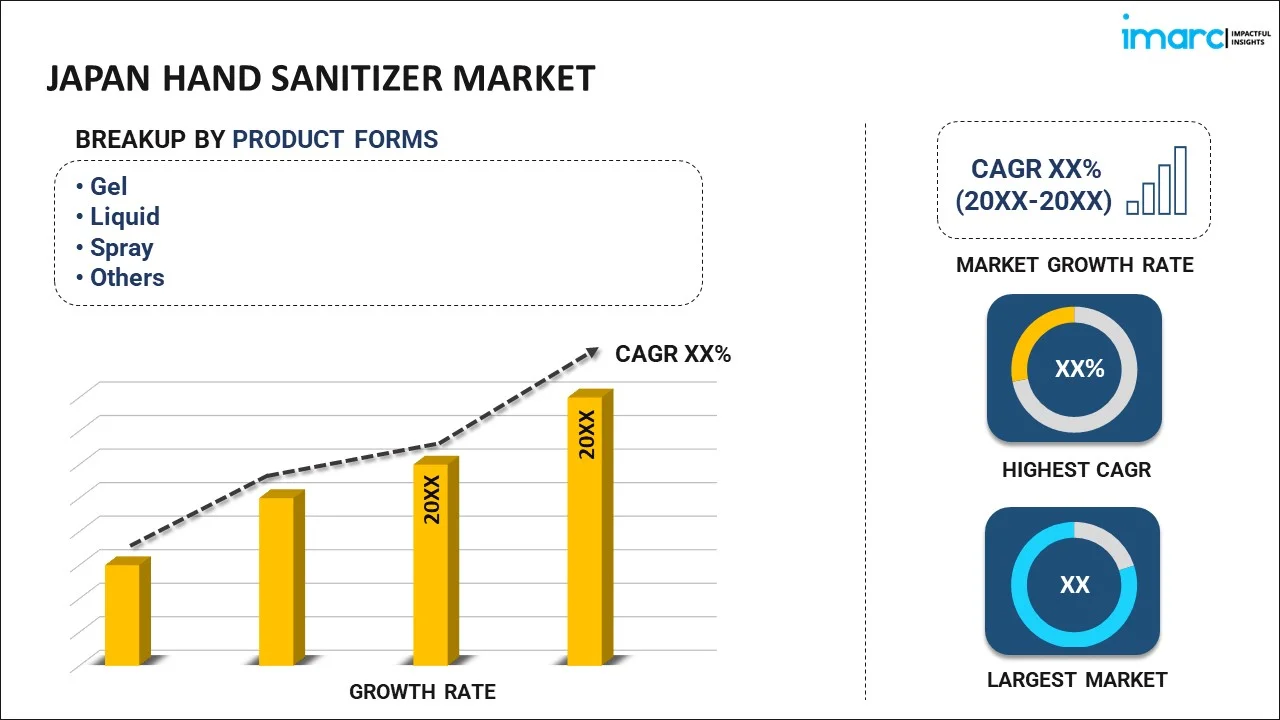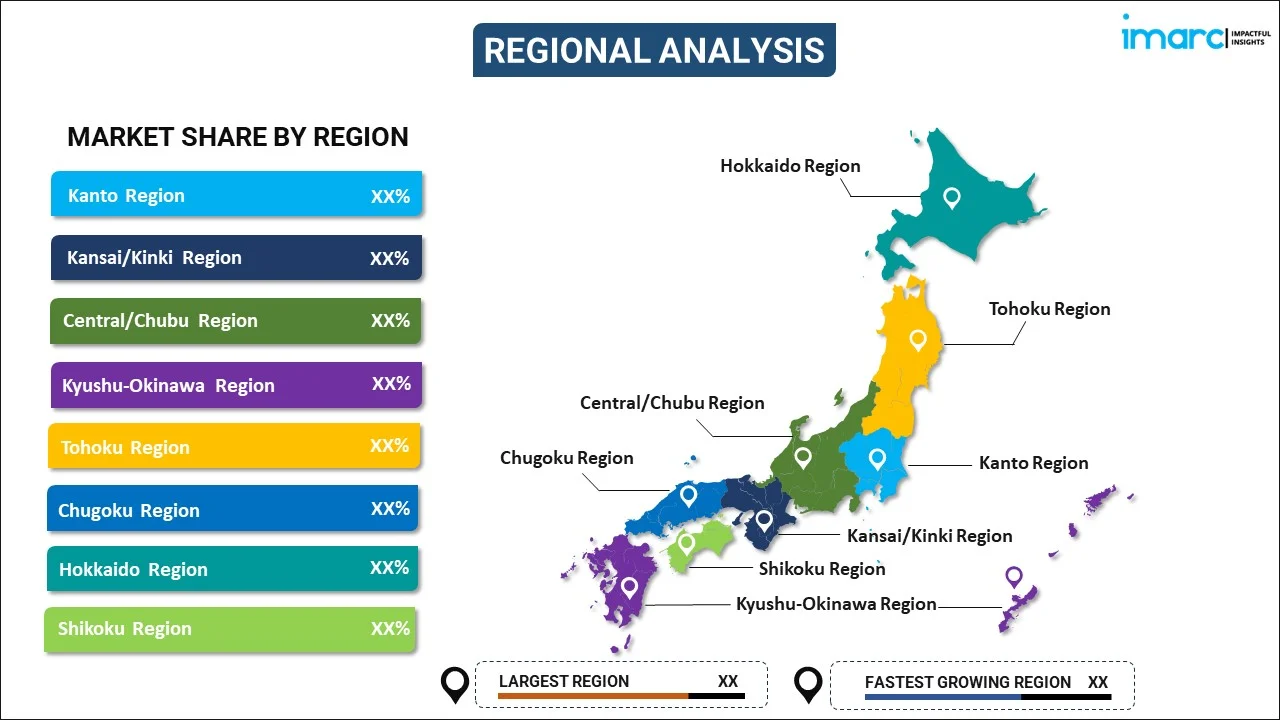
Japan Hand Sanitizer Market Report by Product Form (Gel, Liquid, Spray, Foam, and Others), Product Type (Alcohol-Based, Non-Alcohol Based), Distribution Channel (B2B, B2C), End Use (Hospitals, Households, Manufacturing, Hospitality, Restaurants, Government/Utilities, Schools and Educational Institutes, Enterprise and Commercial Facilities, Recreational and Entertainment Centers, Agriculture, and Others), and Region 2025-2033
Market Overview:
Japan hand sanitizer market size reached USD 161.5 Million in 2024. Looking forward, IMARC Group expects the market to reach USD 110.8 Million by 2033. The rise of e-commerce platforms, which has made it easier for consumers to access and purchase hand sanitizers online, is primarily driving the market.
|
Report Attribute
|
Key Statistics
|
|---|---|
|
Base Year
|
2024
|
|
Forecast Years
|
2025-2033
|
|
Historical Years
|
2019-2024
|
|
Market Size in 2024
|
USD 161.5 Million |
|
Market Forecast in 2033
|
USD 110.8 Million |
Hand sanitizer is a widely used hygiene product designed to effectively kill or reduce harmful microorganisms on the hands, primarily bacteria and viruses. It typically consists of alcohol, water, and other inactive ingredients. The alcohol content, often ethyl alcohol or isopropyl alcohol, is the active ingredient responsible for sanitizing the hands. Hand sanitizer is available in various forms, including gel, foam, and liquid, and is usually stored in portable containers for convenient use. In recent years, hand sanitizer has gained significant popularity due to its convenience and effectiveness in preventing the spread of infectious diseases, especially in situations where soap and water are not readily available. Regular use of hand sanitizer can help reduce the risk of infection transmission, but it is not a substitute for proper handwashing with soap and water, which remains the gold standard for hand hygiene. Nevertheless, hand sanitizer plays a crucial role in maintaining hand cleanliness and promoting public health, particularly in situations where traditional handwashing is impractical.
Japan Hand Sanitizer Market Trends:
The hand sanitizer market in Japan has witnessed unprecedented growth in recent years, driven primarily by several key factors. Firstly, the heightened awareness of personal hygiene and sanitation practices has become a cultural shift, with consumers now integrating hand sanitizers into their daily routines. This cultural transformation has contributed to a sustained demand for hand sanitizers, extending beyond the immediate pandemic response. Additionally, advancements in product formulations and packaging have played a crucial role in propelling the hand sanitizer market forward. Manufacturers have developed innovative sanitizer solutions, offering various options, including alcohol-based and non-alcohol-based sanitizers, scented varieties, and eco-friendly alternatives. These options cater to a diverse range of consumer preferences, further fueling market expansion. Apart from this, regulatory agencies and public health organizations have continued to emphasize the importance of hand sanitizers in infection prevention, further validating the market's significance. As a result, businesses across various industries, including hospitality, healthcare, and retail, have integrated hand sanitizing stations and products into their operations, driving the growth of the hand sanitizer market in Japan.
Japan Hand Sanitizer Market Segmentation:
IMARC Group provides an analysis of the key trends in each segment of the market, along with forecasts at the country level for 2025-2033. Our report has categorized the market based on product form, product type, distribution channel, and end use.
Product Form Insights:

- Gel
- Liquid
- Spray
- Foam
- Others
The report has provided a detailed breakup and analysis of the market based on the product form. This includes gel, liquid, spray, foam, and others.
Product Type Insights:
- Alcohol-Based
- Non-Alcohol Based
A detailed breakup and analysis of the market based on the product type have also been provided in the report. This includes alcohol-based, and non-alcohol based.
Distribution Channel Insights:
- B2B
- B2C
- Hypermarkets and Supermarkets
- Pharmacy Stores
- Departmental Stores
- Online Stores
- Others
The report has provided a detailed breakup and analysis of the market based on the distribution channel. This includes B2B and B2C (hypermarkets and supermarkets, pharmacy stores, departmental stores, online stores, and others).
End Use Insights:
- Hospitals
- Households
- Manufacturing
- Hospitality
- Restaurants
- Government/Utilities
- Schools and Educational Institutes
- Enterprise and Commercial Facilities
- Recreational and Entertainment Centers
- Agriculture
- Others
A detailed breakup and analysis of the market based on the end use have also been provided in the report. This includes hospitals, households, manufacturing, hospitality, restaurants, government/utilities, schools and educational institutes, enterprise and commercial facilities, recreational and entertainment centers, agriculture, and others.
Regional Insights:

- Kanto Region
- Kansai/Kinki Region
- Central/ Chubu Region
- Kyushu-Okinawa Region
- Tohoku Region
- Chugoku Region
- Hokkaido Region
- Shikoku Region
The report has also provided a comprehensive analysis of all the major regional markets, which include Kanto Region, Kansai/Kinki Region, Central/ Chubu Region, Kyushu-Okinawa Region, Tohoku Region, Chugoku Region, Hokkaido Region, and Shikoku Region.
Competitive Landscape:
The market research report has also provided a comprehensive analysis of the competitive landscape. Competitive analysis such as market structure, key player positioning, top winning strategies, competitive dashboard, and company evaluation quadrant has been covered in the report. Also, detailed profiles of all major companies have been provided.
Japan Hand Sanitizer Market Report Coverage:
| Report Features | Details |
|---|---|
| Base Year of the Analysis | 2024 |
| Historical Period | 2019-2024 |
| Forecast Period | 2025-2033 |
| Units | Million USD |
| Scope of the Report | Exploration of Historical Trends and Market Outlook, Industry Catalysts and Challenges, Segment-Wise Historical and Future Market Assessment:
|
| Product Forms Covered | Gel, Liquid, Spray, Foam, Others |
| Product Types Covered | Alcohol-Based, Non-Alcohol Based |
| Distribution Channels Covered |
|
| End Uses Covered | Hospitals, Households, Manufacturing, Hospitality, Restaurants, Government/Utilities, Schools and Educational Institutes, Enterprise and Commercial Facilities, Recreational and Entertainment Centers, Agriculture, Others |
| Regions Covered | Kanto Region, Kansai/Kinki Region, Central/ Chubu Region, Kyushu-Okinawa Region, Tohoku Region, Chugoku Region, Hokkaido Region, Shikoku Region |
| Customization Scope | 10% Free Customization |
| Post-Sale Analyst Support | 10-12 Weeks |
| Delivery Format | PDF and Excel through Email (We can also provide the editable version of the report in PPT/Word format on special request) |
Key Questions Answered in This Report:
- How has the Japan hand sanitizer market performed so far and how will it perform in the coming years?
- What has been the impact of COVID-19 on the Japan hand sanitizer market?
- What is the breakup of the Japan hand sanitizer market on the basis of product form?
- What is the breakup of the Japan hand sanitizer market on the basis of product type?
- What is the breakup of the Japan hand sanitizer market on the basis of distribution channel?
- What is the breakup of the Japan hand sanitizer market on the basis of end use?
- What are the various stages in the value chain of the Japan hand sanitizer market?
- What are the key driving factors and challenges in the Japan hand sanitizer?
- What is the structure of the Japan hand sanitizer market and who are the key players?
- What is the degree of competition in the Japan hand sanitizer market?
Key Benefits for Stakeholders:
- IMARC’s industry report offers a comprehensive quantitative analysis of various market segments, historical and current market trends, market forecasts, and dynamics of the Japan hand sanitizer market from 2019-2033.
- The research report provides the latest information on the market drivers, challenges, and opportunities in the Japan hand sanitizer market.
- Porter's five forces analysis assist stakeholders in assessing the impact of new entrants, competitive rivalry, supplier power, buyer power, and the threat of substitution. It helps stakeholders to analyze the level of competition within the Japan hand sanitizer industry and its attractiveness.
- Competitive landscape allows stakeholders to understand their competitive environment and provides an insight into the current positions of key players in the market.
Need more help?
- Speak to our experienced analysts for insights on the current market scenarios.
- Include additional segments and countries to customize the report as per your requirement.
- Gain an unparalleled competitive advantage in your domain by understanding how to utilize the report and positively impacting your operations and revenue.
- For further assistance, please connect with our analysts.
 Inquire Before Buying
Inquire Before Buying
 Speak to an Analyst
Speak to an Analyst
 Request Brochure
Request Brochure
 Request Customization
Request Customization




.webp)




.webp)












